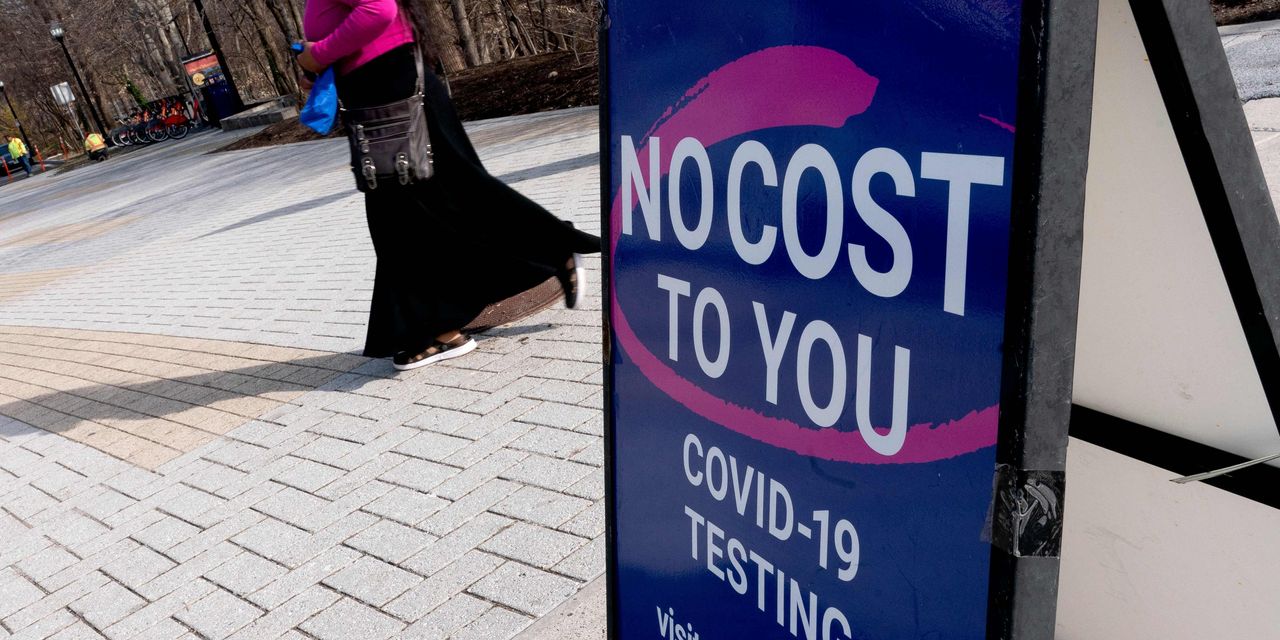COVID-19 cases and hospitalizations in the U.S. are rising and intensive-care-unit beds are being filled again, in a trend that may spell an end to the stable period the country experienced during the fall months.
The daily average of new cases was up 22% on Thursday from two weeks ago, to 49,070, according to a New York Times tracker. Cases are rising in 40 states, led by Oklahoma, where they are up 89% from two weeks ago.
The daily average for hospitalizations is up 21% from two weeks ago to 33,708, although as always, the trend is not uniform across the nation. Louisiana is the state with the highest increase in hospitalizations, up 109% from two weeks ago, followed by California, where they have climbed 66%.
Visits to the ICU are up 17%, while test-positivity rates are up 29%, to 10%, the tracker shows. On a brighter note, the daily average for deaths is down 3% to 274.
Experts are warning that new omicron subvariants are on the rise and are quickly replacing earlier ones.
The most recent data release from the Centers for Disease Control and Prevention showed that the BQ.1.1 and BQ.1 sublineages of BA.5 accounted for 62.8% of all cases in the U.S. in the week through Dec. 3, exceeding the 13.8% of cases caused by BA.5.
That was up from 57.3% of cases in the week through Nov. 26, when 19.4% of cases were caused by BA.5.
In the New York region, which includes New Jersey, Puerto Rico and the U.S. Virgin Islands, those numbers were even higher, with BQ.1 and BQ.1.1 accounting for 72.4% of all cases, compared with 6.9% for BA.5.
That was up from the prior week, when BQ.1 and BQ.1.1 accounted for 70.8% of all cases, compared with 10.4% for BA.5.
See now: Elon Musk may want employees back in the office, but 29% of Americans still work from home
For now, the new sublineages have not been shown to be likely to cause more severe disease than earlier ones, but they are more transmissible, which is why they have become dominant.
Experts continue to urge people to get their updated booster, which is the best protection against developing severe COVID or dying of it.
Coronavirus Update: MarketWatch’s daily roundup has been curating and reporting all the latest developments every weekday since the coronavirus pandemic began
Other COVID-19 news you should know about:
• Local governments in China are facing a new challenge in the battle against COVID: They are running out of cash needed to finance mass testing and enforce quarantines, CNN reported on Friday. The zero-COVID policy kept China out of recession in 2020, but now the bills are mounting, placing financial strain on municipal authorities across the world’s most populous nation, said CNN. For nearly three years, local governments have borne the brunt of enforcing pandemic controls.
• Former NBA star Jeremy Lin, who plays for a Chinese team, was fined 10,000 yuan ($1,400) for criticizing quarantine facilities, according to China’s professional league and a news report Friday, the AP reported. The ruling Communist Party is trying to crush criticism of the human cost and disruption of its zero-COVID strategy, which has confined millions of people to their homes.
• Formula One confirmed Friday that the Chinese Grand Prix will not take place in 2023, making it the fourth year in a row the race has been canceled because of the coronavirus pandemic, the AP reported separately. “Formula One can confirm, following dialogue with the promoter and relevant authorities, that the 2023 Chinese Grand Prix will not take place due to the ongoing difficulties presented by the COVID-19 situation,” Formula One said in a statement.
• German doctors are warning that pediatric units are stretched to the breaking point in some hospitals in part due to rising cases of respiratory infections among infants, the AP reported. The intensive-care association DIVI said the seasonal surge in cases of respiratory syncytial virus and a shortage of nurses was causing a “catastrophic situation” in hospitals. RSV is a common, highly contagious virus that infects nearly all babies and toddlers by age 2, some of whom can fall seriously ill. Experts say the easing of coronavirus pandemic restrictions means RSV is currently affecting a larger number of babies and children whose immune systems aren’t primed to fend off the infection.
Here’s what the numbers say:
The global tally of confirmed cases of COVID-19 topped 644.1 million on Friday, while the death toll rose above 6.63 million, according to data aggregated by Johns Hopkins University.
The U.S. leads the world with 98.9 million cases and 1,081,147 fatalities.
The Centers for Disease Control and Prevention’s tracker shows that 228.4 million people living in the U.S., equal to 68.8% of the total population, are fully vaccinated, meaning they have had their primary shots.
So far, just 39.7 million Americans have had the updated COVID booster that targets the original virus and the omicron variants, equal to 12.7% of the overall population.
